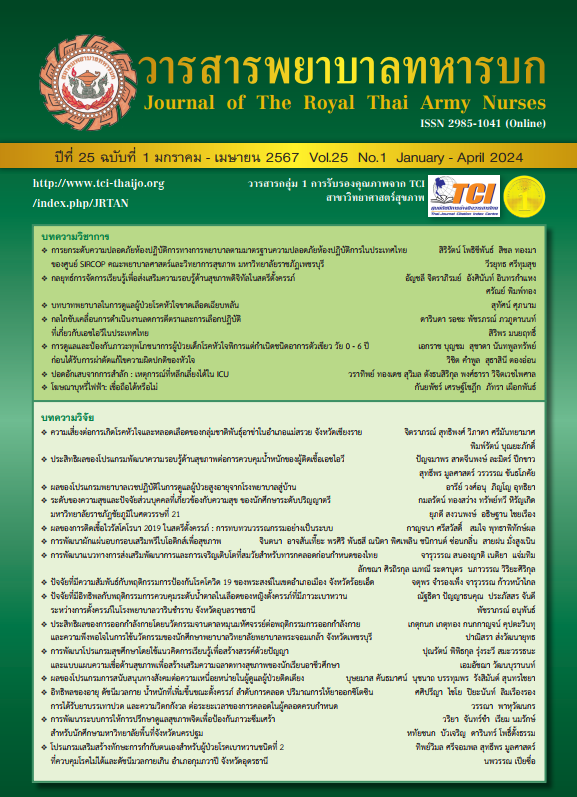Functional and Cognitive Status and Driving Cessation among Senior Road Users
Keywords:
Physical status, Cognitive status, Senior, Driving cessationAbstract
Senior road users in Thailand face issues due to the aging population. The study aimed to analyze seniors’ physical, cognitive state, and their choices related to driving. Data collected from 268 participants in Phayao province. The tools used included a personal data record form and a form regarding the intention to stop driving vehicles. Additionally, a physical and cognitive performance assessment form was utilized to evaluate the range of motion in the joints, color blindness, depth perception, peripheral vision, brake reaction time, rapid pace walks, and clock drawing test. Most participants were married, primarily educated, and 64.8% had co-morbidities. Bicycles and motorcycles were favored transport modes, primarily used during the morning. Sixty-seven percent of participants reported visual problems; many exhibited a limited range of motion and have no intention to stop driving/riding. The study underlined the need for targeted interventions and policies to tackle specific problems faced by elderly road users, such as medical conditions, sensory impairments, and cognitive decline, to improve road safety and well-being.
Downloads
References
National Economic and Social Development Board. Thailand’s Aging Society Situation in 2020-2040. In: Development National Economic and Social Development, editor. Bangkok: National Economic and Social Development 2020. (in Thai)
Department of Older Persons. Statistics of the elderly in Thailand’s 77 provinces as of December 31, 2022. In: Department of Older Persons, editor. Bangkok: Department of Older Persons; 2022. (in Thai)
Seresirikachorn K, Singhanetr P, Soonthornworasiri N, Amornpetchsathaporn A, Theeramunkong T. Characteristics of road traffic mortality and distribution of healthcare resources in Thailand. Scientific Reports 2022;12:20255.
World Health Organization. Motorcycle ABS to save lives. Khonkhan: Road Safety Foundation; 2020.
Engel, GL. The clinical application of the biopsychosocial model. American Journal of Psychiatry Journal. 1980;137(5), 535-44.
Pilotto A, Cella A, Pilotto A, Daragjati J, Veronese N, Musacchio C, Panza F, et al. Three decades of comprehensive geriatric assessment: Evidence coming from different healthcare settings and specific clinical conditions. Journal of the American Medical Directors Association. 2017;18(2): 192.e1-192.e11.
Karthaus M, Falkenstein M. Functional changes and driving performance in older drivers: Assessment and interventions. Geriatrics. 2016;1(2):1-18.
Frontera WR., Silver JK, Rizzo TD. Essentials of physical medicine and rehabilitation: Musculoskeletal disorders, pain, and rehabilitation. 4th ed: Elsevier; 2020.
Gill TK, Shanahan EM, Tucker GR, Buchbinder R, Hill CL. Shoulder range of movement in the general population: age and gender stratified normative data using a community-based cohort. BMC Musculoskeletal Disorders. 2020;21(676):1-9.
Roman de Mettelinge T, Desimpelaere P, Cambier D. Cervical mobility and cervical proprioception in relation to fall risk among older adults: A prospective cohort study. European Geriatric Medicine. 2023; 14(3): 447-53.
Hetal VV, Jasmin HJ, Gandotra A, Shah GV. A study on range of movement (radial deviation, ulnar deviation, flexion and extension) of wrist joint. International Journal of Health Sciences and Research. 2016;6(5):94-100.
Zwerus EL, Willigenburg NW, Scholtes VA, Somford MP, Eygendaal D, van den Bekerom MP. Normative values and affecting factors for the elbow range of motion. Shoulder and Elbow. 2019;11(3):215-24.
Feng YR, Meuleners L, Stevenson M, Heyworth J, Murray K, Fraser M, et al. The impact of cognition and gender on speeding behavior in older drivers with and without suspected mild cognitive impairment. Clinical Interventions in Aging. 2021;6(16):1473-83.
Mohammaddokht S, Saadati M, Kashefimehr B, Azami-Aghdash S. Assessing and improving fitness to drive in the elderly people: A scoping review of policies and guidelines. Iranian Journal of Public Health. 2022;51(11): 2404-16.
Remillard ET, Campbell ML, Koon LM, Rogers WA. Transportation challenges for persons aging with mobility disability: Qualitative insights and policy implications. Disability and Health Journal. 2022;15(1)::2-10.
Ravensbergen L, Newbold KB, Ganann R, Sinding C. ‘Mobility work’: Older adults’ experiences using public transportation. Journal of Transport Geography. 2021;97(2):103221.
Chayaopas N, Kasemsiri P, Thanawirattananit P, Piromchai P, Yimtae K. The effective screening tools for detecting hearing loss in elderly population: HHIE-ST Versus TSQ. BioMed Central Geriatrics. 2021;21(1):1-9.
Na Nakorn P, Detprapon M. Hearing impairment nursing care of ear and hearing health promotion in older persons. Nursing Research and Innovation Journal. 2021;27(2):151-62. (in Thai)
Toups R, Chirles TJ, Ehsani JP, Michael JP, Bernstein JPK, Calamia M, et al. Driving performance in older adults: current measures, findings, and implications for roadway safety. Innovation in Aging. 2022;6(1):1-13.
Fraade-Blanar LA, Ebel BE, Larson EB, Sears JM, Thompson HJ, Chan KCG, et al. Cognitive decline and older driver crash risk. Journal of the American Geriatrics Society. 2018;66 (6):1075-81.
Nozawa T, Taki Y, Kanno A, Akimoto Y, Ihara M, Yokoyama R, et al. Effects of different types of cognitive training on cognitive function, brain structure, and driving safety in senior daily drivers: A pilot study. Behavioural Neurology. 2015;525901:1-18.
Ross LA, Freed SA, Edwards JD, Phillips CB, Ball K. The impact of three cognitive training programs on driving cessation across 10 years: A randomized controlled trial. Gerontologist. 2017;57(5):838-46.
Balzarotti S, Pagani E, Telazzi I, Gnerre M, Biassoni F. Driving-related cognitive abilities: Evaluating change over time in a sample of older adults undergoing an assessment regarding fitness to drive. International Journal of Environmental Research and Public Health. 2022;19(19):12806.
Castellucci HI, Bravo G, Arezes PM, Lavallière M. Are interventions effective at improving driving in older drivers?: A systematic review. BioMed Central Geriatrics. 2020;20(1):1-25.
Pan D, Pellicori P, Walklett C, Green A, Masse AR, Wood J, et al. Driving habits and reaction times on a driving simulation in older drivers with chronic heart failure. The Journal of Cardiac Failure. 2020;26(7):555-63.
Rongmuang D, Pauchpanpisan C, Nakchatree C, Tongdee J. Effect of Thengtuk Dance Exercise on the cognitive function in the elderly. Journal of the Royal Thai Army Nurses 2023;24(2):278-89. (In Thai)
Fields NL, Cronley C, Mattingly SP, Roark EM, Leat SR, Miller VJ. Transportation mobility and health among older adults: Examining missed trips and latent demand. Journal of Transport and Health 2021;21(2):101069.
Downloads
Published
How to Cite
Issue
Section
License
Copyright (c) 2024 Journal of The Royal Thai Army Nurses

This work is licensed under a Creative Commons Attribution-NonCommercial-NoDerivatives 4.0 International License.
บทความหรือข้อคิดเห็นใดใดที่ปรากฏในวารสารพยาบาลทหารบกเป็นวรรณกรรมของผู้เขียน ซึ่งบรรณาธิการหรือสมาคมพยาบาลทหารบก ไม่จำเป็นต้องเห็นด้วย
บทความที่ได้รับการตีพิมพ์เป็นลิขสิทธิ์ของวารสารพยาบาลทหารบก
The ideas and opinions expressed in the Journal of The Royal Thai Army Nurses are those of the authors and not necessarily those
of the editor or Royal Thai Army Nurses Association.






